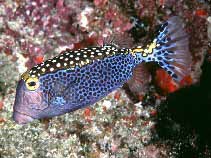Biology:Spotted boxfish
| Spotted boxfish | |
|---|---|

| |
| Scientific classification | |
| Domain: | Eukaryota |
| Kingdom: | Animalia |
| Phylum: | Chordata |
| Class: | Actinopterygii |
| Order: | Tetraodontiformes |
| Family: | Ostraciidae |
| Genus: | Ostracion |
| Species: | O. meleagris
|
| Binomial name | |
| Ostracion meleagris G. Shaw, 1796
| |
The spotted or white-spotted boxfish (Ostracion meleagris), is a species of boxfish found in the Indian and Pacific Oceans. It is found on reefs at depths of from 1 to 30 metres (3.3 to 98.4 feet). This species grows to a length of 25 centimetres (9.8 inches). Males and females differ in colour: males are blackish on the back with white spots, and have bluish sides with bright yellowish bands and spots. Females and juveniles are dark brown to blackish with white spots.[1] As with other species of boxfish, the spotted boxfish's bony carapace gives it a distinctly angular appearance; it has been described as resembling an ottoman.[2]
Description & Anatomy
The Spotted Boxfish has an oblong thick body that are enclosed in a bony box formed by thickened, joined, enlarged, and hexagonal scale plates.[3] Juveniles with male patterns or colors are never seen or has never been spotted before; either the juvenile males are born with the female colors, or all the young juveniles are born as a female and change their sex later in their life. [4]
Their diet consists of sponges, worms, tunicates as well as other small invertebrates.[5]
Their box has openings for the mouth, eyes, gill slits, fins, and tail base. Their backs are slightly rounded. They have a pair of longitudinal ridges on their lower flanks, a flat bottom, and no spines. Their small mouth opens at the front with fleshy lips and has 15 mid-sized teeth on each jaw. Their gill openings are short and form oblique slits in front of their pectoral base. Their anal and dorsal fins are at the rear; their caudal fin is rounded; their dorsal fin has no spines; and, they do not have pelvic fins.[6]
The Spotted Boxfish make noises and sounds during the mating process. For example, when mating, the male or female, sometimes both, make a low pitched humming sound that lasts for about 6 seconds. Another example is after the mating process, when another male comes to “spawn” with the female or to disrupt the mating process, the two males fight each other, sometimes creating an audible thump sound & they even produce a short buzzing sound.[7]
They are protected by a toxic slime that can kill other fish, thus making them unsuitable for use in aquariums.[8]
Habitat
They can be found in the Indo-Pacific Ocean. They can also be found in seaward and protected reefs.[9] That’s just where the adults reside most of the time, whilst the juveniles often find shelter between the long spines of the tropical sea urchins anchored to the rocks.[10]
Reproduction
Phillip Lobel, an ichthyologist, found out that they mate during the afternoon and the early evening hours. The Spotted Boxfish species usually travel in a group, consisting of one male and several females. They start the mating process by the male nudging and circling one female. When she responds, they swim side-by-side while rising 6 ft or more from the bottom. The male leads the female to that point. Staying in that side-by-side formation with their tails together & heads slightly apart from one another, they both release their gametes (a mature haploid male or female germ cell which is able to unite with another of the opposite sex in sexual reproduction) and swim back to the bottom again together. Unfortunately, when that process is done and they both are with each other at the bottom again, it calls males to the female Boxfish to disrupt the process or calls them to mate with her instead, and that’s why fights are not uncommon between male Spotted Boxfishes.[11]
References
- Froese, Rainer and Pauly, Daniel, eds. (2012). "Ostracion meleagris" in FishBase. October 2012 version.
- ↑ Dianne J. Bray, 2011, Black Boxfish, Ostracion meleagris, in Fishes of Australia, accessed 07 Oct 2014, http://www.fishesofaustralia.net.au/home/species/2475
- ↑ Cara Giaimo, "How the World's Squarest Fish Gets Around", in The New York Times , 15 Apr. 2020.
- ↑ "Spotted Boxfish" (in en-US). 2015-04-05. https://mexican-fish.com/spotted-boxfish/.
- ↑ "hawaiisfishes.com - John Hoover's home page - books, apps & more". http://www.hawaiisfishes.com/.
- ↑ Sutton, Alan (2014-10-29). "White Spotted Boxfish- Facts and Photographs" (in en-US). https://seaunseen.com/spotted-boxfish/.
- ↑ "Spotted Boxfish" (in en-US). 2015-04-05. https://mexican-fish.com/spotted-boxfish/.
- ↑ "hawaiisfishes.com - John Hoover's home page - books, apps & more". http://www.hawaiisfishes.com/.
- ↑ "Spotted Boxfish" (in en-US). 2015-04-05. https://mexican-fish.com/spotted-boxfish/.
- ↑ Sutton, Alan (2014-10-29). "White Spotted Boxfish- Facts and Photographs" (in en-US). https://seaunseen.com/spotted-boxfish/.
- ↑ admin. "Homepage" (in it-IT). https://www.monaconatureencyclopedia.com/.
- ↑ "hawaiisfishes.com - John Hoover's home page - books, apps & more". http://www.hawaiisfishes.com/.
External links
- Photos of Spotted boxfish on Sealife Collection
Wikidata ☰ Q497346 entry
 |

